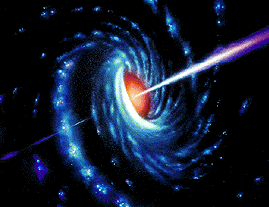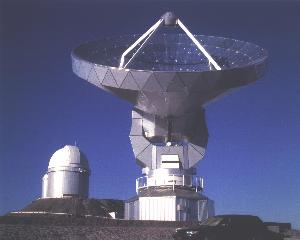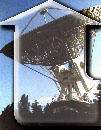Metsähovi Radio Observatory
Quasar Research
The largest research program in Metsähovi is the study of quasars and other Active Galactic Nuclei (AGNs). We work in very close collaboration with the Tuorla Observatory AGN group, having several joint research projects, student exchange, etc.

Main research topics
- Radio variability: long term behaviour, statistics, source populations, radio variability models.
- Multifrequency studies: radio to gamma-ray connection in blazars, radio vs. optical behaviour, multifrequency variability models.
- AGN contribution to the extragalactic foreground: pre-launch work for the Planck surveyor satellite to study extragalactic point sources.
- Inverted-spectrum sources: compact steep-spectrum (CSS) sources, Gigahertz-peaked spectrum (GPS) sources, high-frequency peakers, variable flat-spectrum sources; long term studies, multifrequency studies, evolutionary models.
- BL Lacertae Objects: Multifrequency variability, radio behaviour, spectral energy distributions, intermediate BLOs, ultra-high energy peaked BLOs.
- Source populations, source samples, unified models.
Observations
We use the 14 metre radio telescope in Metsähovi to study the long-term variability of a set of sources at 22 and 37 GHz (13 and 8 mm), and observe very large source samples at 37 GHz in order to study the high-frequency radio behaviour of various source populations.
The observations are radio continuum observations and the goal is to obtain the total flux density of the source. At 22 and 37 GHz we use a dual-horn dual beam-switching method which eliminates the effects of the background very efficiently. One integration typically takes ca. 30 minutes, and our detection limit (for S/N > 4) under normal conditions is on the order of 0.3 Jy.
The Metsähovi radio telescope is operated 24 hrs / day, 365 days / year, and a vast majority of the observing time is dedicated for the AGN project. Only rain and snow, or very humid clouds, stop the observations. Nowadays most of the AGN observations are carried out in a semi-automatic mode where human supervision is not constantly needed. We always have one of the team members assigned as an observer for a given observing shift (usually 3-7 days) and human intervention is still required semi-regularly throughout the shift, but this can partly be done via remote access e.g. from the observer's home.
We also use other instruments operating across the electromagnetic spectrum in order to study the multifrequency behaviour of AGNs. We have extensive experience from using the Swedish-ESO Submillimetre Telescope (SEST) to observe Southern and equatorial sources at (sub)millimetre wavelengthts. Our team got an incredible 2614 hours of observing time during its 15 years of operation in 1988-2003.

In addition to the extensive experience from Metsähovi and SEST our team members have personal experience from using the Nordic Optical Telescope (NOT) and the James Clerk Maxwell Telescope (JCMT). Additionally, we have been co-investigators in a large number of projects using other instruments across the electromagnetic spectrum, e.g. VLBA, VLA, CMVA, HALCA, INTEGRAL, XMM-Newton, etc. We also participate in many international multifrequency campaigns organised by the ENIGMA network or the Whole Earth Blazar Telescope (WEBT).
Public outreach
The Metsähovi AGN team members are often seen lecturers at amateur astronomy clubs, schools etc. as well as at "studia generalia" type lectures.
For the Finnish-speaking audience we have a web page introducing quasars and radio observations:
Additional information in Finnish can be found in the lecture material of the TKK course "Radio astronomy", lectured every two years by the Metsähovi research staff (usually by Tornikoski & Lähteenmäki):

|
webmaster@kurp.hut.fi
Last modified: Monday, 18-Jun-2012 12:24:41 EEST |
| Back to Metsähovi home page |